Industrial Visit - Global Steel Company, Hyderabad
Industrial Visit - Global Steel Company, Hyderabad
Event Name: Industrial Visit - Global Steel Company, Hyderabad
Objective: : Industrial Visits enable the students to gain a better understanding of how professionals’ function in the workplace and how classroom knowledge can be applied practically.
Outcome: All the students had an insightful day as they were given the opportunity to apply what they had learned in the classroom.
Report
Prof. P M Balaji, Vice President, Supply Chain Management, Toshiba, organized an Industrial Visit for the MBA – Operations students (Batch 2022-24) on 27th November, 2023. Upon arrival at GSC, Mr. Arjun Singh, the Purchase Head, held a brief introductory meeting and gave an overview about the factory operations.
In the bustling realm of global industries, a recent industrial visit to a prominent steel company opened a gateway to the fascinating universe of steel fabrication. The sprawling facility, with its towering structures and humming machinery, offered a firsthand experience of the intricate processes involved in steel production. The visit was an enlightening journey that delved into various aspects, including fabrication techniques, types of steel used, bill of quantity (BOQ), structural designs, grades of MS steel plates, adherence to Indian standards, and the integration of SAP software for efficient inventory management.
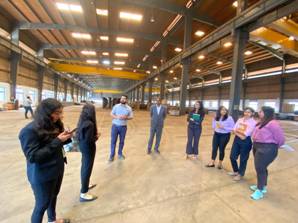
(Introduction speech by the purchase manager )
Fabrication Techniques-
At the heart of the steel company's operations was the art of fabrication, constituting a staggering 90 percent of their projects. Visitors witnessed skilled craftsmen manipulating raw steel into intricate shapes and structures. From welding and cutting to bending and assembling, the facility was a hive of activity, showcasing the precision and expertise required in the fabrication process.
Types of Steel Used-
The company showcased its versatility by employing different types of steel to meet diverse project requirements. Stainless steel, known for its corrosion resistance and aesthetic appeal, stood in stark contrast to mild steel (MS), chosen for its strength and durability. Understanding the distinctive properties of each type shed light on the meticulous selection process that guides the company's material choices.
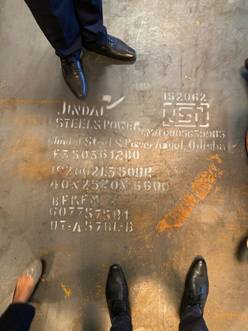
(Types of steel used in the manufacturing )
Bill of Quantity (BOQ)-
The visit also highlighted the significance of the Bill of Quantity (BOQ) in project planning and execution. The BOQ serves as a comprehensive document outlining the materials, quantities, and costs required for a project. Witnessing the meticulous preparation of BOQs emphasized the company's commitment to transparency and efficiency in project management.
Structural Designs-
A significant portion of the visit was dedicated to exploring various structural designs employed by the company. Composite girders, open structures, and bowstring designs were showcased, each serving a specific purpose in diverse applications. The detailed explanations provided by engineers illuminated the structural intricacies and engineering considerations behind each design.
MS Steel Plate Grades-
The facility's extensive use of MS steel plates unveiled a spectrum of grades such as E250B0, E350B0, and E410B0. Each grade possessed unique properties, making them suitable for specific applications. Understanding the distinctions between these grades underscored the importance of selecting the right material for optimal structural performance.
Indian Standards and SAP Software-
As a responsible global player, the company adhered to Indian standards Institute (ISI) in its production processes. The commitment to quality and safety was evident in every aspect of the operation. Additionally, the integration of SAP software for inventory management showcased the company's dedication to leveraging technology for enhanced efficiency in tracking and managing its vast inventory.
Electro-Based Magnet-
Electromagnets play a vital role in diverse applications within a steel company catering to the railways. In scrap yard operations, they are utilized for lifting and sorting ferrous scrap metal, facilitating recycling efforts by recovering metal from discarded rail tracks and other components. In steel manufacturing, electromagnets contribute to the steel melting and casting process, ensuring uniform composition and temperature in electric arc furnaces. Their role extends to material handling, where electromagnetic lifters assist in moving heavy steel materials during manufacturing.
In railway track production, electromagnets are integral to the rail rolling process, manipulating steel billets for track fabrication. Electromagnetic testing methods aid in quality control, detecting defects in steel products for adherence to safety standards. For railway maintenance, electromagnetic inspection tools identify flaws in tracks, facilitating timely repairs.
Additionally, electromagnets find application in ore processing through magnetic separation in the extraction of iron from raw ore. Moreover, they enhance security and safety by employing electromagnetic metal detectors throughout the production and supply chain, ensuring the exclusion of foreign metallic objects from steel products for railway applications. Overall, electromagnets play a pivotal role across various stages of steel production, ensuring the delivery of high-quality steel products to the railway industry.
Plate Processor-
A plate processor, integral to metal fabrication, is employed for the manipulation of metal plates, offering crucial functionalities in shearing, punching, and marking. Its shearing mechanism adeptly reduces large metal plates into more manageable sizes. The machine showcases punching capabilities, facilitating the creation of holes, notches, and diverse shapes in metal plates, serving essential roles in construction and manufacturing. Equipped with marking tools, plate processors enable the application of identification marks, part numbers, or other relevant information onto metal plates.
Modern iterations of plate processors often incorporate automation features, enhancing efficiency and precision by enabling automated systems to execute multiple tasks without manual intervention. Furthermore, some plate processors integrate material handling systems, streamlining the fabrication process through optimized loading, positioning, and unloading of metal plates. In essence, plate processors play a pivotal role in the metal fabrication landscape, offering versatile solutions for diverse tasks involved in processing and manipulating metal plates.
CNC Cutting Machine-
CNC cutting machines, distinguished by their specialization in Computer Numerical Control (CNC)-guided cutting processes, stand out for their adaptability across diverse applications, particularly those involving metal plates. Governed by computer programs ensuring precision, these machines offer a spectrum of cutting methods, including plasma, laser, and waterjet cutting, with the chosen method dependent on material characteristics and desired precision levels. Renowned for excelling in shaping intricate patterns and complex forms, CNC machines derive their precision from programmability, facilitating the production of detailed components.
Notably, these machines seamlessly integrate into automated production lines, enhancing operational efficiency and diminishing reliance on manual labour during cutting processes. Beyond their prowess in metal cutting, CNC machines exhibit versatility by accommodating various materials such as plastics, wood, and composites, rendering them suitable for a broad range of applications.
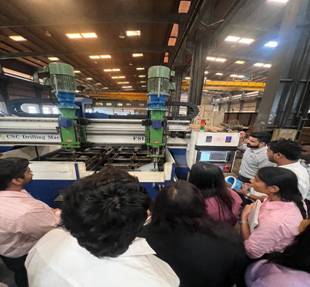
(Purchase Head explaining the working of CNC Drilling Machine )
In contrast to the specialized functions of plate processors in handling metal plates, CNC cutting machines emerge as versatile tools pivotal for intricate and precise cutting across diverse materials, collectively contributing to heightened efficiency and precision in metal fabrication processes.
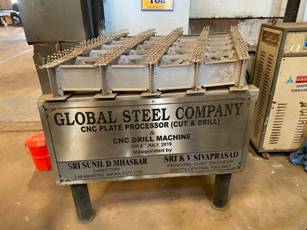
(CNC plate processor (cut and drill))
I-Section (Composite Gudder)-
The sections of a steel beam, typically used in construction and structural applications, the terms "top flange," "web," and "bottom flange" are components of an I-beam or H-beam.
Top Flange: This is the horizontal section at the top of the I-beam. It helps distribute the load and provides stability to the structure. The width and thickness of the top flange can vary based on the specific requirements of the structural design.
Web: The web is the vertical section that connects the top and bottom flanges. It resists shear forces and provides the primary structural support. The thickness of the web is an essential factor in determining the beam's overall strength.
Bottom Flange: Similar to the top flange, the bottom flange is the horizontal section at the bottom of the I-beam. It also contributes to load distribution and stability. The dimensions of the bottom flange, like those of the top flange, depend on the structural requirements.
In steel companies, these sections are crucial components in the manufacturing and fabrication of structural steel elements. They are used in the construction of buildings, bridges, and various infrastructure projects. The dimensions and specifications of these sections are carefully designed to meet the structural demands of specific applications, ensuring the overall strength and stability of the constructed elements. If you have a more specific question or if there's another context you're referring to, please provide additional details for a more precise response.
SMAW (Shielded Metal Arc Welding)-
Shielded Metal Arc Welding, commonly known as SMAW or stick welding, is a manual arc welding process. In SMAW, an electrode with a flux-coated outer layer is used. As the welder strikes an arc, the flux coating melts, forming a protective gas shield around the weld area. This shield prevents atmospheric contaminants from affecting the weld and facilitates the formation of a solid, high-strength joint between the metals.
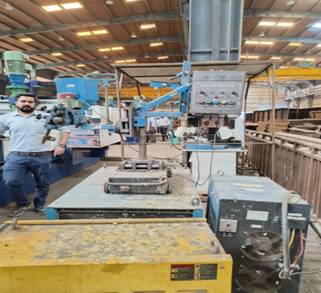
(SAW Controller)
SMAW is versatile and can be used in various positions, making it suitable for construction, maintenance, and repair work. Its simplicity and portability make it a preferred choice in field welding applications, and its effectiveness in welding different metals contribute to its widespread use in the industry.
Steel Manufacturing: In the production phase, SMAW is utilized for welding steel components during the fabrication of structures, machinery, and other steel products. This process is particularly valuable in joining heavy steel plates and structural elements in the manufacturing of steel components.
Repair and Maintenance: SMAW plays a crucial role in the repair and maintenance of equipment, machinery, and infrastructure within steel plants. Welders use SMAW to address issues like cracks, wear, or damage in steel components, ensuring the longevity and reliability of the equipment.
GMAW (Gas Metal Arc Welding)-
Gas Metal Arc Welding, commonly referred to as GMAW or MIG (Metal Inert Gas) welding, is an automated or semi-automated welding process. In GMAW, a continuous wire electrode is fed through a welding gun, and an inert gas, typically argon or a mixture of argon and carbon dioxide, is used as a shielding gas. The electric arc is formed between the wire and the workpiece, melting the wire and creating a weld pool. GMAW is known for its high welding speed, efficiency, and ability to produce high-quality welds. It is widely used in manufacturing, fabrication, and automotive industries for its versatility in welding various metals and thicknesses. The process can be adapted for different welding positions, and its automation capabilities make it suitable for both large-scale production and precision work.
Automated Production Lines: GMAW is often integrated into automated production lines in steel manufacturing. Its high welding speed and efficiency make it suitable for mass production of steel components, such as automotive parts and structural elements.
Precision Welding: In steel fabrication, GMAW is employed for precision welding, ensuring clean and precise welds. This is essential in the production of components where accuracy and aesthetics are critical, such as architectural elements or high-end machinery parts.
Common Applications for Both Processes-
Railway Components: Steel companies supplying to the railways utilize welding processes for the fabrication of railway tracks, bridges, and other infrastructure components. Both SMAW and GMAW can be employed based on the specific requirements of the project.
Structural Welding: Whether constructing steel buildings, bridges, or other structures, welding is fundamental. SMAW and GMAW are employed to join steel members, providing structural integrity and ensuring the durability of the overall construction.
Quality Control and Inspection: Both welding processes are used in quality control and inspection applications. Non-destructive testing methods, including visual inspection and various testing techniques, help ensure that welded joints meet the required standards for strength and safety.
Shot Blasting Machines-
Shot blasting machines are indispensable in steel companies, serving diverse roles in surface preparation and treatment of steel products. The process involves propelling abrasive particles, such as steel shots or grits, at high speeds onto steel surfaces to achieve various outcomes. Primarily, shot blasting is utilized for surface cleaning, removing rust, scale, and contaminants, preparing steel for subsequent treatments like coating or welding. It effectively eliminates undesired elements, such as burrs and sharp edges, contributing to the precision and safety of steel components.
Additionally, shot blasting aids in achieving specific surface profiles, promoting better adhesion of coatings and providing desired textures. In steel manufacturing, it plays a pivotal role in descaling hot-rolled steel and preparing steel castings and forgings.
The versatility of shot blasting extends to applications like shot peening, enhancing the fatigue resistance and durability of steel components in industries such as aerospace and automotive. In essence, shot blasting machines play a crucial role in elevating the quality, longevity, and performance of diverse steel products across various sectors.
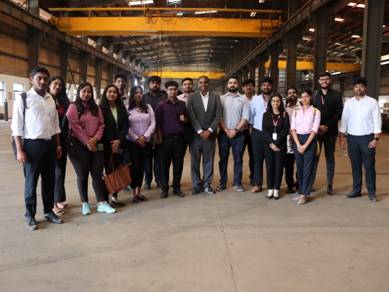
(Student Group Photo with Faculty Guide and The Staff Member)

